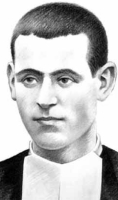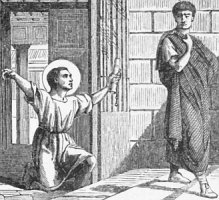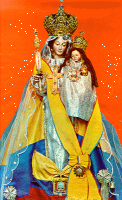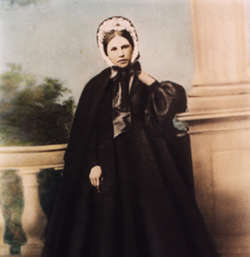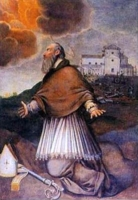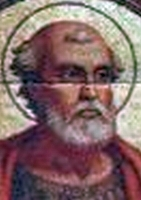St. Lucretia
Feastday: November 22
Death: 306
Virgin martyr of western Spain, who was put to death in Merida during the Roman persecutions.
Blessed Tommaso Reggio
Profile
Son of Angela Pareto and the Marquis of Reggio. Tommaso felt a call to the priesthood at age 20; he studied and was ordained on 18 September 1841. Vice-rector of the seminary in Genoa, Italy at age 25. Rector of the seminary in Chiavari, Italy.
Helped found The Catholic Standard, the first Catholic newspaper. In 1865 the Standard and 25 other papers supported slates of Catholic candidates, hoping to found a Catholic political party. However, in 1874 Catholics were told they could not vote, and Father Tommaso closed the paper.
Bishop of Ventimiglia, Italy in 1877; the diocese was so poor, Tommaso had to travel to his parishes on a mule. He opened new parishes, organized three synods and liturgical revival, set up teaching programs. Prayed every night from 3 to 6 a.m., and never let anyone see him worry. Founded the Sisters of Saint Martha in 1878, a congregation devoted to caring for the poor.
Following an earthquake in 1887, he worked with the injured in the rubble, and ordered his priests to use all resources to help the displaced. Founded orphanages at Ventimiglia and San Remo, Italy to house, educate, and train children who had lost their families in the quake.
In 1892 he asked the Pope to relieve him of his duties; instead, on 11 July the Pope appointed him archbishop of Genoa, Italy. The city was politically complex and tense, but his humble, open, pious generosity won over many, and people in and out of the Church came to him with problems. Set up a network to help immigrants, worked for Catholic lay associations, supported limited work hours and complete days off for working people - radical notions in those days. He died while on pilgrimage with a group of other bishops and clergy.
Born
8 January 1818 at Genoa, Italy
Died
• afternoon of 22 November 1901 at Triora, Imperia, Italy of natural causes
• funeral held at the Cathedral of San Lorenzo, Genoa, Italy
Beatified
• 3 September 2000 by Pope John Paul II
• the beatification miracle involved the healing of Pabla Valdenegro Romero, a six-year-old girl, of Guillain-Barré Syndrome (polyradiculoneuritis), with albumin-cytological dissociation, ascending paralysis with cranial nerve involvement, quadriplegia, prolonged respiratory failure, two cardiac arrests, subcutaneous emphysema, and other infectious pulmonary complications in Valpariso, Chile, on 10 November 1985
Saint Cecilia
புனிதர் செசிலியா
கன்னியர் மற்றும் மறைசாட்சி:
(Virgin and Martyr)
பிறப்பு: கி.பி. இரண்டாம் நூற்றாண்டு
ரோம், இத்தாலி
(Rome, Italy)
இறப்பு: நவம்பர் 22, 230
சிசிலி
(Sicily)
ஏற்கும் சமயம்:
ரோமன் கத்தோலிக்க திருச்சபை
(Roman Catholic Church)
லத்தீன் கத்தோலிக்க திருச்சபை
(Latin Catholic Church)
கிழக்கு கத்தோலிக்க திருச்சபை
(Eastern Catholic Church)
ஆங்கிலிக்கன் திருச்சபை
(Anglican Church)
கிழக்கு மரபுவழி திருச்சபை
(Eastern Orthodox)
முக்கிய திருத்தலம்:
தூய செசிலியா தேவாலயம், ட்ரஸ்டேவெர், ரோம்
(Santa Cecilia in Trastevere, Rome)
பாதுகாவல்:
பாசுரங்கள் (Hymns), இசைக்கலைஞர்கள், கவிஞர்கள், "ஒமாஹா பேராயம்" (Archdiocese of Omaha), அர்ஜென்ட்டினா (Argentina), “மர் டெல் ப்லடா” – ஒரு அர்ஜென்டினிய நகரம் (Mar del Plata – An Argentinian City), ஃபிரான்ஸ் (France)
புனிதர் செசிலியா, இசைக்கலைஞர்களின் பாதுகாவலர் ஆவார். தமது திருமணத்தின்போது, தமது மனதுக்குள் கடவுளிடம் பாடினார் என்று எழுதி வைக்கப்பட்டுள்ளது. திருப்பலியின்போது, பெயர் சொல்லி நினைவு கூறப்படும் (அன்னை கன்னி மரியாளைத் தவிர்த்து) ஏழு பெண்களுள் செசிலியாவும் ஒருவர் ஆவார்.
அவரது சரித்திர விவரங்கள் கற்பனையாக இருப்பதாகத் தோன்றினாலும், அவரது இருப்பு மற்றும் மறைசாட்சியம், ஒரு வரலாற்று உண்மை என்றே கருதப்படுகிறது. ரோம் நகரின் “டிரஸ்டேவியர்” (She is said to have been beheaded with a sword) பகுதியிலுள்ள, நான்காம் நூற்றாண்டில் நிறுவப்பட்ட, “தூய செசிலியா” (Santa Cecilia) எனும் ஒரு ஆதி கிறிஸ்தவ ரோமன் தேவாலயத்தின் பக்கத்திலயே செசிலியா வசித்துவந்ததாகவும் கூறப்படுகிறது. பல்வேறு இசையமைப்புகள் அர்ப்பணிக்கப்பட்டுள்ள புனிதர் செசிலியாவின் நினைவுத் திருநாள், நவம்பர் மாதம் 22ம் நாள் கொண்டாடப்படுகின்றது.
ரோம் நகரின் பிரப்புக்கள் குடும்பமொன்றினைச் சேர்ந்த பெண்ணான செசிலியா, தமது கணவரான “வலேரியன்” (Valerian), கணவரின் சகோதரரான “’டிபர்ஷியஸ்” (Tiburtius), மற்றும் “மேக்சிமஸ்” (Maximus) எனும் பெயர்கொண்ட ரோம சிப்பாய் ஆகியோர் “பேரரசர் அலெக்சாண்டர் செவெரஸ்” (Emperor Alexander Severus) காலத்தில், சுமார் கி.பி. 230ம் ஆண்டில் மறைசாட்சியராக மரித்தனர்.
ஓரு ரோமன் கத்தோலிக்க குடும்பத்தில் பிறந்து, கிறிஸ்துவுக்காக வாழ வேண்டுமென்று சிறுவயதிலிருந்தே விரும்பியவர் புனிதர் செசிலியா ஆவார். இளம் வயதிலேயே தன் கன்னிமையை கடவுளுக்கு அர்ப்பணம் செய்ததால் திருமணம் செய்துகொள்ள விரும்பவில்லை. ஆனால் இவரின் பெற்றோர் செசிலியாவை “வலேரியன்” (Valerian) என்ற “பாகன் இன பிரபுத்துவ” (Pagan Nobleman) இளைஞர் ஒருவருக்கு திருமணம் செய்ய நிச்சயம் செய்தனர். ஆனால் அதனை செசிலியா பெரிதாக கருதாமல் தன்னுடைய ஆன்மீக காரியங்களில் மட்டுமே கருத்தாக இருந்தார். வலேரியனுடன் திருமணம் செய்யவிருப்பதை வெறுத்தார். இருப்பினும் பெற்றோரை எதிர்த்து அவரால் ஒன்றும் செய்ய இயலாமல் தவித்தார்.
திருமண நாள் வந்தது. இவரின் பெற்றோர் இவருக்கு திருமண உடையை அணிவித்தபோது இதயம் வலித்தவராய், தன்னை முழுவதும் தன் மணவாளன் இயேசுவிடம் ஒப்படைத்து செபித்தார். பெற்றோர் இவரை கணவரிடம் ஒப்படைத்தபோது, தான் கடவுளிடம் கொடுத்த கற்பு என்னும் வார்த்தைப்பாட்டை உன்னிடம் இழக்கமாட்டேன் என்று உறுதியாக தெளிவாக கூறினார். தான் கடவுளுக்கு மட்டுமே சொந்தமானவள் என்பதை தைரியமாக எடுத்துக்கூறினார்.
அவள் தன் கணவனை நோக்கி, "கடவுளின் தூதர் ஒருவர் என் கற்புக்கு காவலராய் இருக்கிறார். எனவே, என்னுடைய கன்னிமைக்கு தீங்கிழைக்கக்கூடிய அல்லது கடவுளது கோபத்தை உம்மீது வரச்செய்யும்படியான எதையும் செய்ய நீர் முயற்சிக்கலாகாது" என்றாள்.
வலேரியன், செசிலியா சொல்வது உண்மையா என்பதை சோதிக்கும் நோக்குடன், "கடவுளின் அந்தத் தூதரை நான் பார்ப்பேனானால் இயேசு கிறிஸ்துவை விசுவசிப்பேன்" என்றார்.
செசிலியா அதை நிரூபிக்க வேண்டுமானால், வலேரியன் முதலில் திருத்தந்தை “அர்பனிடம்” (Pope Urban) சென்று திருமுழுக்குப் பெற்று வருமாறு கூறினார். செசிலியாவின் வார்த்தைகளுக்கு சம்மதித்து, அவரும் திருமுழுக்கு பெற்றார். அவர் திருமுழுக்கு பெற்ற நாளன்றே வானதூதர் ஒருவர் அவர் முன்னின்று செசிலியாவுக்கு ரோஜா மலர் கிரீடம் அணிவித்து வாழ்த்தியதைக் கண்டார்.
அதன்பின்னர் வலேரியன் செசிலியாவை அவரின் விருப்பப்படி வாழ விட்டுவிட்டார். செசிலியாவை நம்பினார். வலேரியன் தன் குடும்ப உறுப்பினர்கள் அனைவரையும் கத்தோலிக்க திருச்சபைக்கு மனமாற்றினார். அவர்கள் அனைவரும் மனமாற்றம் பெற்ற நாளிலிருந்து செசிலியாவிற்கு பணிந்து இரவும் பகலும் அவருக்கு பணிவிடை புரிந்தனர்.
செசிலியா, தான் மணந்த வலேரியனின் உதவியுடன் கடவுளின் அன்பை உணர்ந்து வாழ்ந்தார். ஏழைகளின் மீது இரக்கம் காட்டி, அனைவரையும் சமமாக அன்பு செய்தார். இறைவனை இரவும் பகலும் பாடல்களால் போற்றிப் புகழ்ந்தார்.
இவரின் பக்தியைக் கண்ட எதிரிகளில் ஒருவனான அரசு அதிகாரியான "டுர்சியஸ் அல்மசியஸ்" (Turcius Almachius) என்பவன் செசிலியாவை கூரிய குறுவாளால் மூன்றுமுறை அவரது கழுத்திலேயே குத்தினான். மரணத்தின் விளிம்பில் வீழ்ந்த செசிலியா, தம்மை தேவாலயத்திற்கு இட்டுச்செல்லுமாறு திருத்தந்தையிடம் வேண்டினார். அதன்பின் மூன்றே நாட்கள் உயிர்வாழ்ந்த செசிலியா மறைசாட்சியாக உயிர் துறந்தார்.
புனிதர் “கல்லிஸ்டஸ்” (Catacombs of St. Callistus) கல்லறை நிலத்தில் அடக்கம் செய்யப்பட்ட செசிலியாவின் உடல் 'ட்ரஸ்ட்டேவேர்" எனும் இடத்திலுள்ள "தூய செசிலியா” தேவாலயத்திற்கு (Church of Santa Cecilia in Trastevere) மாற்றப்பட்டது. கி.பி. 1599ம் ஆண்டில், அவரது உடல் அழிந்துபோகாமல் உறங்குவது போல் காணப்பட்டதாக கூறப்படுகிறது.
இவர் கிறிஸ்தவ பெண்கள் அனைவருக்கும் சிறந்ததோர் எடுத்துக்காட்டாக திகழ்ந்தார். கிறிஸ்துவின் மீது கொண்ட அன்புக்காக கன்னிமை காத்து வாழ்ந்தார். அவருக்காக மறைசாட்சியாகவும் மரித்தார்.
Also known as
Cecily, Cicilia
Profile
Cultivated young patrician woman whose ancestors loomed large in Rome's history. She vowed her virginity to God, but her parents married her to Valerian of Trastevere. Cecilia told her new husband that she was accompanied by an angel, but in order to see it, he must be purified. He agreed to the purification, and was baptised; returning from the ceremony, he found her in prayer accompanied by a praying angel. The angel placed a crown on each of their heads, and offered Valerian a favor; the new convert asked that his brother be baptised.
The two brothers developed a ministry of giving proper burial to martyred Christians. In their turn they were arrested and martyred for their faith. Cecilia buried them at her villa on the Apprian Way, and was arrested for the action. She was ordered to sacrifice to false gods; when she refused, she was martyred in her turn.
The Acta of Cecilia includes the following: "While the profane music of her wedding was heard, Cecilia was singing in her heart a hymn of love for Jesus, her true spouse." It was this phrase that led to her association with music, singers, musicians, etc.
Died
• martyred in the 3rd century
• suffocated for a while, and when that didn't kill her, she was beheaded
• her grave was discovered in 817, and her body removed to the church of Saint Cecilia in Rome
• the tomb was opened in 1599, and her body found to be incorrupt
Patronage
• Academy of Music, Rome, Italy
• for bodily purity
• composers
• luthiers
• martyrs
• music
• musicians
• musical instrument makers
• poets
• singers
• Albi, France, archdiocese
• Omaha, Nebraska, archdiocese of
• Valleyfield, Québec, diocese of
• Acquasparta, Italy
• Albi, France, city of
Blessed Anna Kolesárová
Also known as
Anka Kolesárová
Profile
Daughter of Ján "Hruska" Kolesár and Anna (née Kusnírová), she was born into a pious farming family and baptized at the age of one day. Anna's mother died when the girl was ten years old, and she did her best to run the household for her father and brother, Michal. When Russian soldiers were liberating her area of Slovakia from Nazi occupation near the end of World War II, local families hid from them due to their rough, violent reputation, and to avoid the combat that went on around their villages. On 22 November 1944, Anna was discovered by a drunken Red Army soldier who made her cook for him, and then demanded sex. She refused and ran to her father and brother, but was gunned down by the soldier. Martyr.
Born
14 July 1928 in Vysoká nad Uhom, diocese of Kosice, Czechoslovakia (in the modern Slovak Republic)
Died
• shot in the chest and the face with a rifle on 22 November 1944 in Pavlovce nad Uhom, Kosice, Slovak Republic
• buried in a shallow grave on the evening of the next day by her family who still had to spend most of their time in hiding due the combat around them
• re-buried and given proper funeral rites by Father Anton Lukác on 29 November 1944; he immediately begin conducting his own preliminary investigation into her Cause for Canonization
• during the period of Communist Czechoslovakia, mention of the incident and gatherings at her grave were prohibited
• since the fall of the Communist government, her grave has become a pilgrimage site for young people including the Catholic youth organization Domcek which is dedicated to her memory
Beatified
1 September 2018 by Pope Francis
Blessed Salvatore Lilli
Also known as
Salvatore of Cappadocia
Profile
Son of Vincenzo and Annunziata Lilli. Joined the Franciscans in 1870, making his vows on 6 August 1871. Studied at the Franciscan seminary in the Holy Lands. Ordained in Bethlehem on 6 April 1878. Missionary in Jerusalem for two years. Missionary to Marasco, Armenia in 1880. In addition to preaching the faith he built schools, clinics, and homes for the abandoned, and taught modern hygiene and sanitation in the remote villages. Worked endlessly with the sick during a cholera epidemic in 1891. Missionary to Mujuk-Deresa, Armenia in 1894. In 1895 the area was occupied by Islamic Turks who captured Salvatore and several fellow Franciscans. They were tortured and ordered to convert; they all refused. One of the Martyrs of Armenia.
Born
19 June 1853 at Cappadocia, Aquila, Italy
Died
stabbed with a lance on 22 November 1895 near the Zihun River in Mujuk-Dersi, Armenia (in modern Turkey)
Beatified
3 October 1982 by Pope John Paul II
Saint Pedro Esqueda Ramírez
Additional Memorial
21 May as one of the Martyrs of the Mexican Revolution
Profile
Priest. Vicar-general of the diocese of San Juan de los Lagos, Mexico. Discerning a need for religious education for children, he founded catechetical study centers. Martyr.
Born
29 April 1887 in San Juan de los Lagos, Jalisco, diocese of San Juan de los Lagos, Mexico
Died
• shot three times on 22 November 1927 in Teocaltitán, Jalisco, Mexico
• buried at the church of San Juan Bautista, San Juan de los Lagos, Jalisco, diocese of San Juan de los Lagos, Mexico
Canonized
21 May 2000 by Pope John Paul II
Blessed Francisco Lahoz Moliner
Also known as
Brother Bertrán Francisco
Profile
Baptized at the age of one day. Joined the Brothers of the Christian Schools at Cambrils, Spain on 10 August 1925, making his vows on 2 February 1929. Teacher and catechist of novices. Imprisoned and martyred in the Spanish Civil War.
Born
15 October 1912 in Campos, Teruel, Spain
Died
• 22 November 1936 in Picadero de Paterna, Valencia, Spain
• buried in a common grave in Valencia
Beatified
11 March 2001 by Pope John Paul II
Blessed Julián Torrijo Sánchez
Also known as
Brother Elías Julián
Profile
Baptized at the age of one day. Joined the Brothers of the Christian Schools in Cambrils, Spain on 13 November 1916. Teacher and youth minister at a series of schools beginning in 1920. Imprisoned and martyred in the Spanish Civil War.
Born
17 November 1900 in Torrijo del Campo, Teruel, Spain
Died
22 November 1936 in Picadero de Paterna, Valencia, Spain
Beatified
11 March 2001 by Pope John Paul II
Saint Philemon
Profile
First century Christian convert at Colossae, Phrygia, brought to the faith by Saint Paul the Apostle. Married to Saint Apphia. Subject of Paul's canonical Epistle to Philemon in which he asks Philemon to accept back the runaway slave Saint Onesimus, receiving him as a brother Christian; tradition says that he freed the slave. Martyred with Saint Apphia.
Died
stoned to death in the 1st century at Colossae, Phrygia
Saint Amphilochius of Iconium
Profile
Successful 4th-century lawyer who gave up the worldly life to live as a hermit. Bishop of Iconium. Worked with Saint Basil to govern the Church in Cappadocia. Friend of Saint Gregory of Nazianzen who wrote highly of him. Attended the Council of Constantinople in 381. Worked with Saint Jerome. Supported the theological teaching on the Divinity of the Holy Ghost. Opposed Macedonius. Presided over the Council at Sida in Pamphylia.
Saint Ananias of Arbela
Also known as
• Ananias of Erbel
• Ananio of...
Profile
Imprisoned, tortured and martyred in the persecutions of king Shapur II.
Died
• scourged and left for dead on the side of the road in 345 in Arbela, Persia (in modern Iran)
• found by local Christians and taken home where he he died the next day from his injuries
Blessed Ferran Llovera Pulgsech
Also known as
Father Ferran Maria
Profile
Carmelites of the Ancient Observance priest. Martyred in the Spanish Civil War.
Born
19 March 1902 in Orfans, Girona, Spain
Died
22 November 1936 in Montjuïc, Barcelona, Spain
Beatified
28 October 2007 by Pope Benedict XVI
Saint Benignus of Milan
Also known as
Benigno
Profile
Educated in Rome, Italy. Archbishop of Milan, Italy c.470, serving during a period of barbarian invasion.
Died
c.477 in Milan, Italy of natural causes
Saint Apphia
Profile
Married to Saint Philemon. Martyr.
Died
stoned to death in the 1st century at Colossae, Phrygia
Saint Maurus of North Africa
Profile
Raised in a Christian family in North Africa. Immigrant to Rome, Italy. Martyred in the persecutions of Emperor Numerian.
Saint Deyniolen the Younger
Also known as
Daniel, Dayniol, Deiniol, Deyniolin
Profile
Abbot in Bangor Abbey in Wales.
Died
621
Saint Pragmatius of Autun
Also known as
Prammazio, Pragmazio
Profile
Bishop of Autun, France.
Died
c.520
Saint Stephen of Antioch
Profile
Martyr.
Died
Antioch, Pisidia (in modern Turkey)
Saint Sabinian the Abbot
Profile
Abbot of Moutier-Saint-Chaffre in the Diocese of Le Puy, France.
Died
c.720
Saint Mark of Antioch
Profile
Martyr.
Died
Antioch, Pisidia (in modern Turkey)
Saint Christian of Auxerre
Profile
Bishop of Auxerre, France.
Died
c.873
Martyrs of Armenia
Profile
A group of eight Franciscans martyred in the region of Mujuk-Dersi, Armenia (modern Turkey) by invading Islamic Turks who tortured them, demanded they convert, and murdered them when they did not. They were
• Baldji Oghlou Ohannes
• David Oghlou David
• Dimbalac Oghlou Wartavar
• Geremia Oghlou Boghos
• Khodianin Oghlou Kadir
• Kouradji Oghlou Tzeroum
• Salvatore Lilli
• Toros Oghlou David
Died
22 November 1895 in Mujuk-Dersi, Armenia (in modern Turkey)
Beatified
3 October 1982 by Pope John Paul II
Martyrs of England, Scotland, and Wales
Profile
85 English, Scottish and Welsh Catholics who were martyred during the persecutions by Protestants in the 16th and 17th centuries. They are commemorated together on 22 November.
• Blessed Alexander Blake • Blessed Alexander Crow • Blessed Antony Page • Blessed Arthur Bell • Blessed Charles Meehan • Blessed Christopher Robinson • Blessed Christopher Wharton • Blessed Edmund Duke • Blessed Edmund Sykes • Blessed Edward Bamber • Blessed Edward Burden • Blessed Edward Osbaldeston • Blessed Edward Thwing • Blessed Francis Ingleby • Blessed George Beesley • Blessed George Douglas • Blessed George Errington • Blessed George Haydock • Blessed George Nichols • Blessed Henry Heath • Blessed Henry Webley • Blessed Hugh Taylor • Blessed Humphrey Pritchard • Blessed John Adams • Blessed John Bretton • Blessed John Fingley • Blessed John Hambley • Blessed John Hogg • Blessed John Lowe • Blessed John Norton • Blessed John Sandys • Blessed John Sugar • Blessed John Talbot • Blessed John Thules • Blessed John Woodcock • Blessed Joseph Lambton • Blessed Marmaduke Bowes • Blessed Matthew Flathers • Blessed Montfort Scott • Blessed Nicholas Garlick • Blessed Nicholas Horner • Blessed Nicholas Postgate • Blessed Nicholas Woodfen • Blessed Peter Snow • Blessed Ralph Grimston • Blessed Richard Flower • Blessed Richard Hill • Blessed Richard Holiday • Blessed Richard Sergeant • Blessed Richard Simpson • Blessed Richard Yaxley • Blessed Robert Bickerdike • Blessed Robert Dibdale • Blessed Robert Drury • Blessed Robert Grissold • Blessed Robert Hardesty • Blessed Robert Ludlam • Blessed Robert Middleton • Blessed Robert Nutter • Blessed Robert Sutton • Blessed Robert Sutton • Blessed Robert Thorpe • Blessed Roger Cadwallador • Blessed Roger Filcock • Blessed Roger Wrenno • Blessed Stephen Rowsham • Blessed Thomas Atkinson • Blessed Thomas Belson • Blessed Thomas Bullaker • Blessed Thomas Hunt • Blessed Thomas Palaser • Blessed Thomas Pilcher • Blessed Thomas Pormort • Blessed Thomas Sprott • Blessed Thomas Watkinson • Blessed Thomas Whitaker • Blessed Thurstan Hunt • Blessed William Carter • Blessed William Davies • Blessed William Gibson • Blessed William Knight • Blessed William Lampley • Blessed William Pike • Blessed William Southerne • Blessed William Spenser • Blessed William Thomson •
Beatified
22 November 1987 by Pope John Paul II
Also celebrated but no entry yet
• Apostles of Bulgaria
• Martyrs of Forli
• Agabbas of Syria
• Celynin ap Helig
• Eugenia of Matera
• Joan of Montefalco
• Michele Puig






